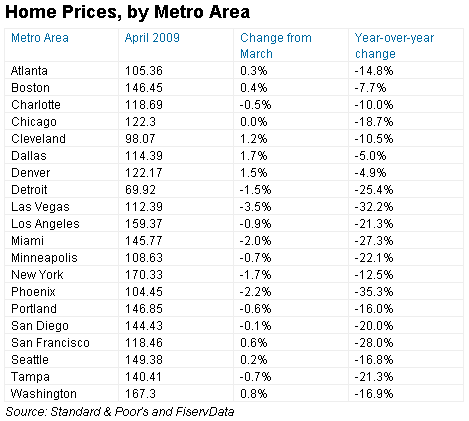 The Case-Shiller housing numbers are out and are being spun as showing signs of improvement. That like beauty is in the eye of the beholder.
The Case-Shiller housing numbers are out and are being spun as showing signs of improvement. That like beauty is in the eye of the beholder.
Here is Reuters report:
Prices of U.S. single-family homes fell in April from March but the pace of the decline moderated, suggesting stability is emerging in some regions, according to Standard & Poor’s/Case Shiller home price indexes released on Tuesday.
An index of 20 metropolitan areas dipped 0.6 percent in April from March, after a 2.2 percent decline the month before, for an 18.1 percent downturn from a year earlier.
The month’s slide was smaller than the 1.8 percent drop forecast in a Reuters poll.
S&P’s index of 10 metropolitan areas declined 0.7 percent in April for an 18 percent year-over-year drop, after falling 2.1 percent month on month in March.
The rate of annual decline in these measures has improved, from 18.7 percent for both indexes in March.
The old second derivative argument but you do have to stop getting worse before you can start getting better. However, here is a note of caution from the WSJ Real Time Economics Blog:
“It is important to understand that these indices are constructed using non-seasonally adjusted sales prices, and therefore when housing activity perks up seasonally in the spring and summer months, any effect on selling prices would not be adjusted out of these data,” said economist Joshua Shapiro at MFR, Inc. “In fact, in 2008, after dropping by an average of 2.4% per month in the first quarter, the composite 20 city index than registered average month-to-month declines of 0.9% during the prime spring and summer selling season before reaccelerating to post an average 2.2% monthly decline in the final four months of the year. We continue to believe that it is unlikely that we are near a bottom in nationwide home prices.”
There’s always someone around these days waiting to throw cold water in your face. For those who like to watch train wrecks here are the latest numbers for the index by city:
About the numbers: The Case Shiller indices have a base value of 100 in January 2000. So a current index value of 150 translates to a 50% appreciation rate since January 2000 for a typical home located within the metro market.

Take a look at the numbers for Phoenix, Atlanta, Detroit and Cleveland. Phoenix and Atlanta are approaching 100 or to put it another way, if you bought a typical home in either city in 2000 you barely made any money at all on a typical home. If you bought in Detroit and Cleveland, your house is worth less now than it was in 2000. Talk about lost decades!
- Bulenox: Get 45% to 91% OFF ... Use Discount Code: UNO
- Risk Our Money Not Yours | Get 50% to 90% OFF ... Use Discount Code: MMBVBKSM
Disclaimer: This page contains affiliate links. If you choose to make a purchase after clicking a link, we may receive a commission at no additional cost to you. Thank you for your support!


Leave a Reply